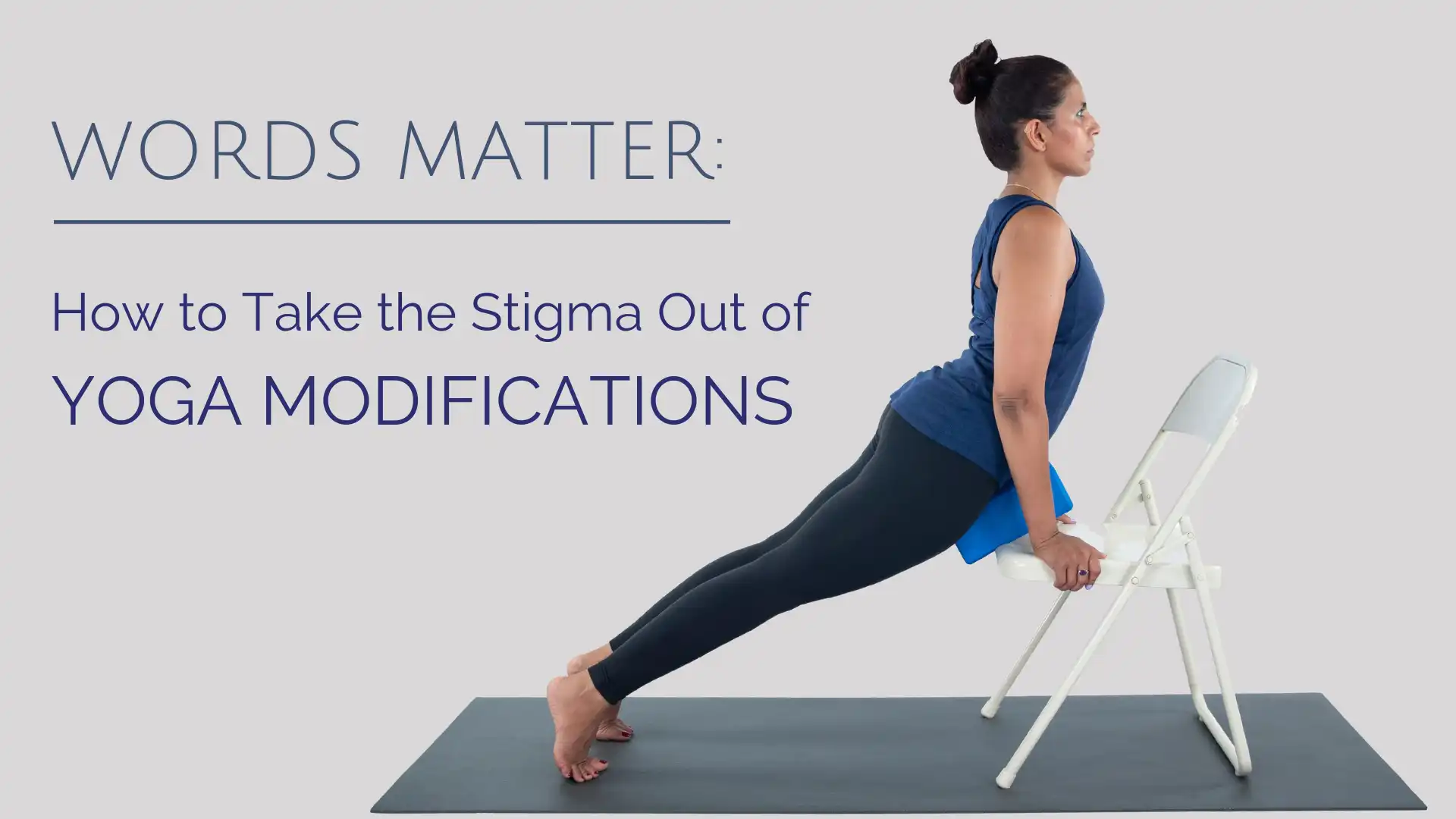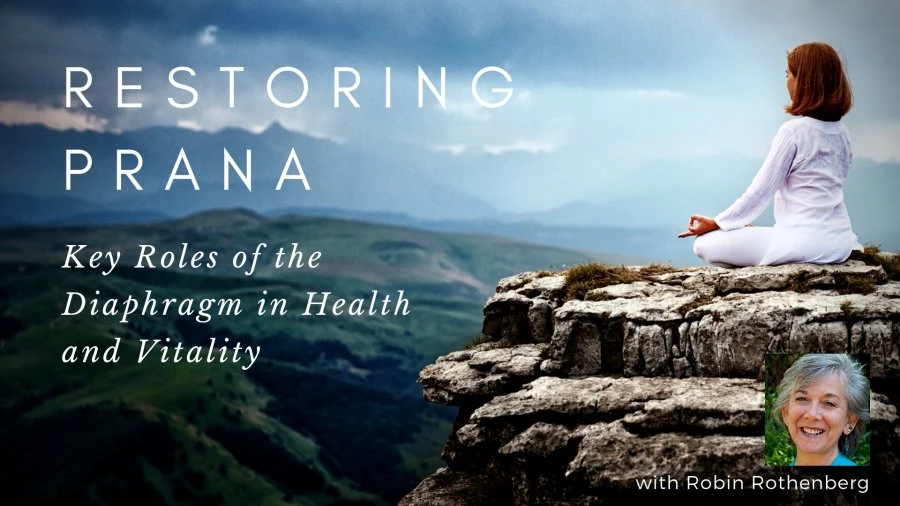Words Matter: How to Take the Stigma Out of Yoga Modifications

As a yoga teacher and an introductory linguist, I’ve grown to appreciate the language of yoga. I’ve realized how important it is to explain our yoga jargon. Often some of the things we say can be abstract. Sometimes we reiterate yoga phrases that we’ve heard as students without investigating the matter further.
“Open the heart” sounds poetic, but what are you actually asking the student to do? Be kinder and more compassionate or to stretch their chest muscles? In other circumstances, our language can be encouraging and also dismissive. One of the words that is often a suspect in my linguistic investigation is “modification.”
To modify means to make something less extreme or more effective by making minor changes to the original. This describes exactly what a yoga modification should be. However, from excessive use in the classroom or without explaining modifications it has morphed into meaning “if you can’t do this, then do that.”
This quick-fix approach to giving students options and moving the class along has not been the most effective use of this word. Students come to class equating the modification to be the pose that one does if they can’t do the “real yoga.” So even if the modification would be useful they are less inclined to choose that option on their own. Also, those with injuries may automatically opt for the modification every single time because their injured body couldn’t possibly do the “harder yoga.”
This outlook actually makes serving our students to the best of our abilities much more difficult. We don’t want them to feel like their body is constantly injured or broken. Nor do we want them to feel that they need to continually do the most intense pose at every practice, despite their limitations, just because mentally they don’t want to practice the “lesser” pose.
After experiencing these outlooks, I’ve decided to change my language and how I look at modifications. I no longer use the word “modifications” in class. Instead, I’ve implemented using the word “version,” and I explain why I’m teaching that particular version of a pose on a given day. “Version” can be defined as an alternate form of something that differs from an earlier or original form of the same thing. Here are my three reasons to use the word “version” instead of the word “modification.”
3 Reasons to Replace “Modification” with “Version”
1.“Version” Does Not Allude to the Pose Being of Any Lesser Value Than Another Pose.
“Version” replaces the hierarchy that “modification” implies. When the options are to practice Adho Mukha Vrksasana (Handstand Pose) or rest in Supta Baddha Konasana (Reclined Bound Angle Pose), the modification for those who don’t want to practice Handstand is to skip practicing Handstand at all. This places a lesser value on the modification because it has very little to do with Handstand.
Instead, for example, you could focus on how to press into the palms in Handstand and the overhead position of the arms in Handstand. Those students who aren’t going upside down or shouldn’t go upside down can practice some of the same principles from Handstand in Adho Mukha Svanasana (Downward-Facing Dog Pose), Balasana (Child’s Pose), Tadasana (Mountain Pose), for example. During one round everyone could stand in Mountain Pose and practice the inverted version of Handstand standing on their feet. In the second round, students can continue to practice Handstand standing on their feet or practice on their hands. This creates immense value for both poses because they target specific actions and create a cohesive group despite their bodies having a different relationship with gravity.
2. Using “Versions” Creates New, Exciting Content For Classes
Teaching alternate versions of poses creates new content for your classes. The student is now asked to leave their yoga auto-tune behind—coming into a pose the same time again and again with little attention to how they are moving their body—and to learn something new in their class without it being called a modification.
Take a pose like Trikonasana (Triangle Pose), for example. Many students want to put their bottom hand on the floor because “that’s just how it’s done.” If you ask your students to grab two or three blocks and to place them to the inside of your front ankle there might be some resistance. But then you show them that for today’s practice you are focusing on externally rotating your upper arms. Instead of placing your hand on the block with the fingers facing forward, you will be practicing keeping your inner upper arm facing forward with your fingers facing your back leg and your inner wrist facing forward.
Now your students are so focused on this new action made possible and normalized by using blocks, they don’t care about placing their palms on the floor. It can be hard to get students to place their hands on a block, but by changing up the dynamics between a modification and a version, their mindset adapts and becomes more open. So the next time around, placing their hands on blocks with the fingers facing forward may not be so difficult, because you are engaging your student to be present in all different angles of the same pose.
3. Practicing a New Version Opens Up Possibilities—We Can Get Stuck in Modifications
If you break your arm, it is put in a cast. The body heals and the cast is taken off. In yoga, the cast of modification gets put on and it rarely comes off. Then the student is only working in a limited range of motion. As a result, they may not have the tools to move into their full range of motion (or to at least experiment) if they are always going straight for the modification.
For example, your student may not do a full squat because of restrictions in their knees, but they can sit in a chair. You could practice a version of Malasana (Squatting Pose) where they are simply seated on a chair. Then the next variation would be to place one block under each foot while they’re sitting in the chair. In the next version, you can add another block and so forth. They could hover slightly away from the chair to make it more active. This gradual scale of variations allows the student to practice a pose they may have thought was off limits. Practicing in this progressive way, they may find that they are able to bend their knees to a higher degree without pain than before.
Yoga modifications aren’t bad. Nor is saying the word “modification.” I suggest noticing your reaction to the word “modification” and the reaction of your students when you say it. Do they opt for it? Do they rely on it? Then if you start incorporating “version” into your yoga teacher vocabulary is there a shift in your class? Using “version” over “modification” can make your yoga teaching more interesting, more diverse and help students advance in their bodies and awareness.
Would you like more yoga asana practice tips? Here’s another article from writer, Allison Schleck – 6 Keys to Healthy Alignment in Ustrasana.
More great information to promote healthy aging- study with YogaUOnline and Robin Rothenberg – Restoring Prana – Key Roles of the Diaphragm in Health and Vitality.
 Allison Schleck, E-RYT 500, RPYT is a vinyasa based yoga teacher, fascinated by the intricate relationship between the mind and body. She offers a range of alignment-focused classes touching on anatomy, philosophy and creative propping with a mindful approach. In addition to teaching group classes and managing the Yoga Culture studio in Danbury, CT, she also teaches at Open Door Family Medical Center in Westchester, NY empowering mother’s to be with prenatal yoga classes and childbirth education. You can find her @allisonschleck on Instagram and www.allisonrayjeraci.com
Allison Schleck, E-RYT 500, RPYT is a vinyasa based yoga teacher, fascinated by the intricate relationship between the mind and body. She offers a range of alignment-focused classes touching on anatomy, philosophy and creative propping with a mindful approach. In addition to teaching group classes and managing the Yoga Culture studio in Danbury, CT, she also teaches at Open Door Family Medical Center in Westchester, NY empowering mother’s to be with prenatal yoga classes and childbirth education. You can find her @allisonschleck on Instagram and www.allisonrayjeraci.com




